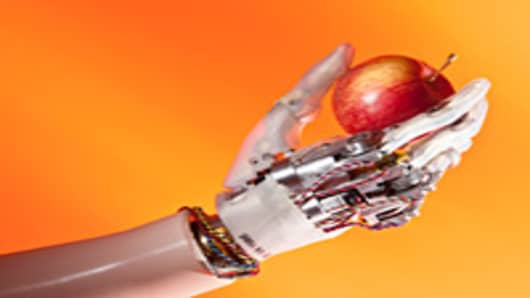A small revolution has been brewing in the development and manufacturing of artificial limbs.
Faced with hundreds of service members returning as amputees from Iraq and Afghanistan, scientists are creating sophisticated prostheses, including hands with articulated fingers. New technology, such as microprocessors and fabrication changes, is allowing advanced manufacturing to create nimble limbs for wounded veterans and other amputees.
Microprocessors or tiny chips have allowed prostheses to adapt to patients — not the other way around, as was the case in the past, says William Hanson, president of Liberating Technologies, a leading prosthetics manufacturer based in Holliston, Mass.
“It’s incredible how it’s changed the way we make and stock products,” says Hanson, whose been in the business for more than 20 years.
More Funding for Research
Artificial limbs used to be clunky and featured analog internal systems. Then in the '90s, prostheses began to incorporate microprocessors.
“Smaller and smaller electronics, and better motors allow more efficient and small drives,” says Harold Sears, president of Motion Control of Salt Lake City, another leading maker of advanced prostheses.
Today, “all analog circuits are almost gone,” Hanson says.
The amputee population is small. Roughly 2 million civilian Americans and 43,000 veterans suffer from limb loss, according to the Amputee Coalition, a nonprofit group based in Knoxville, Tenn. They forecast the amputee population to nearly double to 3.6 million by 2050.
Prosthetic makers are small, private businesses with nowhere near the millions of dollars needed for aggressive research and development. So helping more veteran amputees has fallen on the federal government.
“Private industry wasn’t going to jump in," Hanson says. "Most companies could never recover their investments.”
In 2006, the Defense Advanced Research Projects Agency, part of the Defense Department, launched a $120 million prosthetics program, which has since doled out funding. The program has recruited some of the best engineers and manufacturers in North America, including Liberating Technologies.
“After the conflicts in Iraq and Afghanistan, advancing prostheses has really come to the public eye and lots of money has come with it,” says Kevin Englehart, associate director of the Institute of Biomedical Engineering at the University of New Brunswick.
Englehart and his team in Canada are among the select group of scientists creating advanced artificial limbs.
Neural Prostheses
Worcester Polytechnic Institute researchers have also received federal funding and hope to integrate prosthetic limbs with the body’s nervous system. While years away from broad commercial applications, neural prostheses would allow patients to think about moving an arm or leg, with brain signals traveling to the limb to propel movement.
“These are advances that you really could not do five or six years ago,” says Ted Clancy, an engineering professor at the Massachusetts university.
While neural prostheses are in the robust research phase, the manufacturing focus is currently on advanced, motorized limbs for patients. Sometimes referred to as bionic limbs, they’re in active clinical trials and commercial production.
Imagine fingers that can expand and curl together to pick up small objects like a nail or spoonful of cereal or turn of a door knob; or legs with motorized knees and ankles that allow patients to stand from a seated position.
Erase memories of patients walking stiffly, or artificial arms that essentially have a passive hook on the end for a hand.
Englehart and his New Brunswick colleagues are working on several artificial limb prototypes. A key one is the “UNB" hand that will be controlled through patients’ remaining muscles and cost roughly $23,000.
“There isn’t anything out there with this combination of price and performance,” says Englehart, who is targeting the end of the year for a prototype.
A combination of research and prototypes eventually will merge to create a standardized, modern prosthetic program for all amputees.
"It won't be one single approach," says Eric Overstrom, provost at Worcester Polytechnic.
New Materials, New Manufacturing
New materials and manufacturing techniques are also driving the prosthetic device revolution. For example, improvements in plastic fabrication, moldings and three-dimensional printing have allowed makers to produce better artificial limbs, faster.
But nothing has transformed prostheses the way microprocessors have. And the overall prosthetic strategy is much more efficient.
Manufacturers previously produced many versions of prostheses to fit patients’ varying motor skills. With microprocessors, fewer models are built and stocked.
Functionality can be adjusted by plugging the limbs into a computer and manipulating related software, says Hanson of Liberating Technologies, whose prosthetic research dates to the '60s.
“The first 10 to 12 years were less exciting because technology wasn’t moving as quickly as it is now,” says Hanson.




